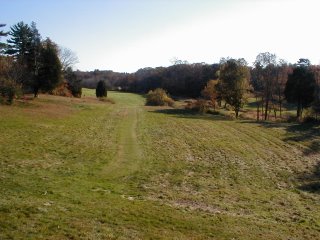Pilgrimage

I recently read The Path: A One-Mile Walk through the Universe by Chet Raymo. I remember reading Raymo’s weekly column in the Boston Globe until, sadly, they were discontinued a few years ago. I stumbled on this book in a bookstore several weeks ago, and remembered I had hoped to read it.
Raymo is professor emeritus of physics and astronomy at
Sheep Pasture is about nine miles by bicycle from our house, and my wife and I rode over there on a bright but blustery and brisk October afternoon. I’ve driven and biked through this area dozens of times in the last two decades, and while I enjoyed the nicely-civilized rural feel of the place, I never paused to take a close look. Now, with Raymo’s book as a guide, I feel motivated to visit this preserve and pay closer attention.
We didn’t stay long this time since the day was mostly about spending a couple of hours on the bike, but we did walk one of the main trails to get a feel for the place. Standing on an overlook that may have been the terrace of a long-gone mansion, a lovely little valley lay before us. A mown field with an inviting footpath down the middle sloped to a meadow cradling a small creek. A few scattered trees in the fields coalesced at the edges into forest that was slowly surrendering its October finery. Informed by Raymo’s history of the estate, I knew that the beauty before me was not entirely the work of nature, but a landscape-sized sculpture created a century ago by Olmstead and his crews.
Our walk took us along this field and others. Scrubby clumps, brushy edges, woodlots, and marshy places told me this would be a great place to visit for some fine spring birding. We passed bluebird boxes put out by Raymo’s friend, Bob the Bluebird Man. I’d love to visit those handsome blue-backed thrushes in April. We commented how lovely this place could be in winter for cross-country skiing. I hoped this would be the first of many visits with newly-opened eyes.
For me, The Path brings to mind a few books that draw a deep map. William Least Heat-Moon, with his tome PrairyErth (a deep map) popularized the phrase with his intense study of a
Anyone could find a place to study and love and chart their own deep map. Some spend hours tending to the plants in the garden. Wilderness lovers have favorite mountain peaks. Paddlers ply the perfect stream. Others rock on the front porch. Worlds of wonder pass a city bench every day. In a way, I hope to do something a little like this with my explorations of Moose Hill. I hope, by getting to know one place well, I will learn to better appreciate all places. And, perhaps I will learn a few things about myself along the way.


7 Comments:
I've never heard of the expression "deep Map" before but it is a wonderful idea. I have put the books you've described on my future reading list.
Seasons come and go and a place changes but it's basic character remains. My place had summer flowers a year ago due to spring rain. This year the rains didn't come until August and the flowers were not the same as the previous year. Two nights each year we hear frogs. This year I found the location. A pond fills when the monsoons come and the frogs resurrect from many months of dormancy. I had walked by the area but never realized it was a pond because it is dry 11 months of the year. Many people travel through and see only an empty desert. I see a living paradise filled with wildlife. Everyone should have a deep map.
Just checked out "The Path" from my local library - now I am really looking forward to finding a quiet corner where I can read :)
I once knew a teacher who, refering to knowledge, said that one may go broad or one may go deep. In other words, you can know a little bit of everything (what they teach children in school) or you can go deeply into a few things. He mentioned how a botanist may know thousands of facts about trees, but never know a tree the way a tribal person, who lived beneath a certain tree for 50 years, knew that tree.
I think it's the same in interpersonal relationships. How wonderful the connection that runs deeply through the years! How much we love that person, how well we know them.
Just so, getting to know a small piece of land. When Jack and I lived at Moss Hill, we loved those three little acres, and we knew every mushroom patch and mossy log.
I'm going to read The Path, too!
Thanks for sharing your vision.
Lilly
I remember Chet's column in the Globe. I enjoyed your post.
Thanks to all who commented on this post. I hope you enjoy Chet Raymo's books. He also has a blog I recently discovered:
http://www.sciencemusings.com/blog/
thank you for your sharing i love your content already..
Post a Comment
<< Home